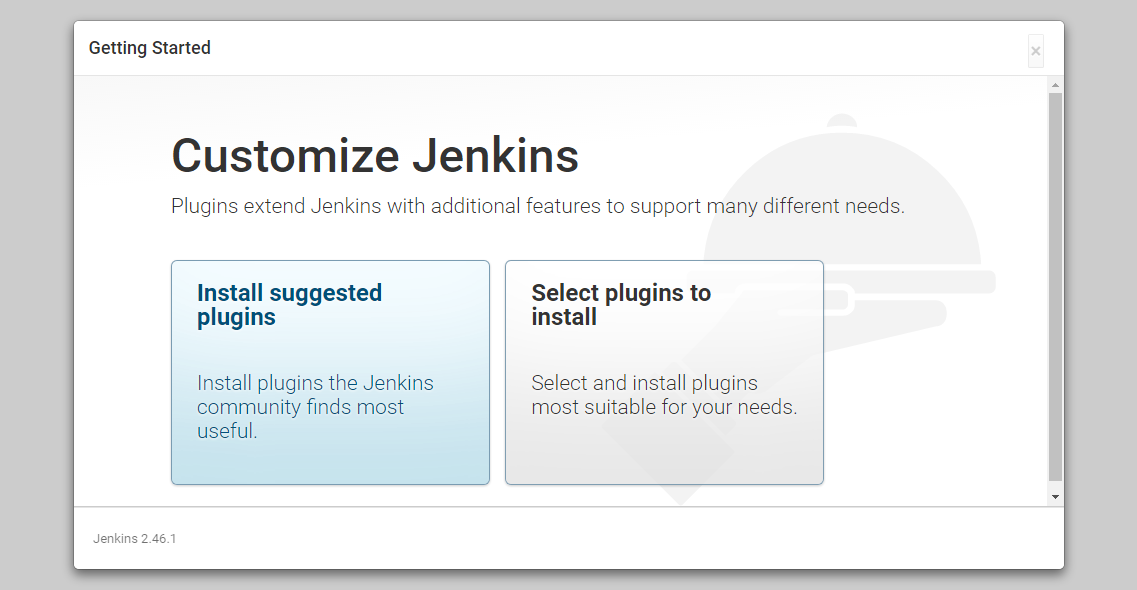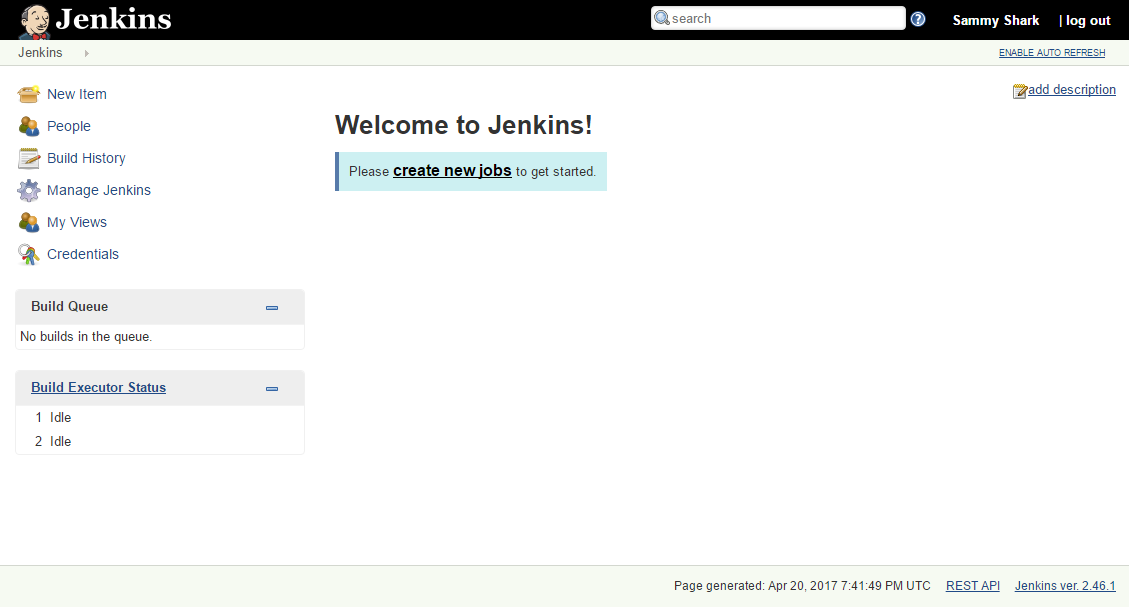- Log in to:
- Community
- DigitalOcean
- Sign up for:
- Community
- DigitalOcean
Not using Ubuntu 16.04?
Choose a different version or distribution.
Introduction
Jenkins is an open source automation server intended to automate repetitive technical tasks involved in the continuous integration and delivery of software. Jenkins is Java-based and can be installed from Ubuntu packages or by downloading and running its Web application ARchive (WAR) file — a collection of files that make up a complete web application which is intended to be run on a server.
In this tutorial we will install Jenkins by adding its Debian package repository, then using that repository to install the package using apt-get.
Prerequisites
To follow this tutorial, you will need:
One Ubuntu 16.04 server configured with a non-root sudo user and a firewall by following the Ubuntu 16.04 initial server setup guide. We recommend starting with at least 1 GB of RAM. See Choosing the Right Hardware for Masters for guidance in planning the capacity of a production Jenkins installation.
When the server is set up, you’re ready to follow along.
Step 1 — Installing Jenkins
The version of Jenkins included with the default Ubuntu packages is often behind the latest available version from the project itself. In order to take advantage of the latest fixes and features, we’ll use the project-maintained packages to install Jenkins.
First, we’ll add the repository key to the system.
- wget -q -O - https://pkg.jenkins.io/debian/jenkins-ci.org.key | sudo apt-key add -
When the key is added, the system will return OK. Next, we’ll append the Debian package repository address to the server’s sources.list:
- echo deb https://pkg.jenkins.io/debian-stable binary/ | sudo tee /etc/apt/sources.list.d/jenkins.list
When both of these are in place, we’ll run update so that apt-get will use the new repository:
- sudo apt-get update
Finally, we’ll install Jenkins and its dependencies, including Java:
- sudo apt-get install jenkins
Now that Jenkins and its dependencies are in place, we’ll start the Jenkins server.
Step 2 — Starting Jenkins
Using systemctl we’ll start Jenkins:
sudo systemctl start jenkins
Since systemctl doesn’t display output, we’ll use its status command to verify that it started successfully:
- sudo systemctl status jenkins
If everything went well, the beginning of the output should show that the service is active and configured to start at boot:
Output● jenkins.service - LSB: Start Jenkins at boot time
Loaded: loaded (/etc/init.d/jenkins; bad; vendor preset: enabled)
Active:active (exited) since Thu 2017-04-20 16:51:13 UTC; 2min 7s ago
Docs: man:systemd-sysv-generator(8)
Now that Jenkins is running, we’ll adjust our firewall rules so that we can reach Jenkins from a web browser to complete the initial set up.
Step 3 — Opening the Firewall
By default, Jenkins runs on port 8080, so we’ll open that port using ufw:
- sudo ufw allow 8080
We can see the new rules by checking UFW’s status.
- sudo ufw status
We should see that traffic is allowed to port 8080 from anywhere:
OutputStatus: active
To Action From
-- ------ ----
OpenSSH ALLOW Anywhere
8080 ALLOW Anywhere
OpenSSH (v6) ALLOW Anywhere (v6)
8080 (v6) ALLOW Anywhere (v6)
Note: If the firewall is inactive, the following commands will make sure that OpenSSH is allowed and then enable it.
- sudo ufw allow OpenSSH
- sudo ufw enable
Now that Jenkins is installed and the firewall allows us to access it, we can complete the initial setup.
Step 4 — Setting up Jenkins
To set up our installation, we’ll visit Jenkins on its default port, 8080, using the server domain name or IP address: http://ip_address_or_domain_name:8080
We should see “Unlock Jenkins” screen, which displays the location of the initial password

In the terminal window, we’ll use the cat command to display the password:
- sudo cat /var/lib/jenkins/secrets/initialAdminPassword
We’ll copy the 32-character alphanumeric password from the terminal and paste it into the “Administrator password” field, then click “Continue”. The next screen presents the option of installing suggested plugins or selecting specific plugins.

We’ll click the “Install suggested plugins” option, which will immediately begin the installation process:

When the installation is complete, we’ll be prompted to set up the first administrative user. It’s possible to skip this step and continue as admin using the initial password we used above, but we’ll take a moment to create the user.
Note: The default Jenkins server is NOT encrypted, so the data submitted with this form is not protected. When you’re ready to use this installation, follow the guide How to Configure Jenkins with SSL using an Nginx Reverse Proxy. This will protect user credentials and information about builds that are transmitted via the Web interface.

Once the first admin user is in place, you should see a “Jenkins is ready!” confirmation screen.
 Click “Start using Jenkins” to visit the main Jenkins dashboard:
Click “Start using Jenkins” to visit the main Jenkins dashboard:

At this point, Jenkins has been successfully installed.
Conclusion
In this tutorial, we’ve installed Jenkins using the project-provided packages, started the server, opened the firewall, and created an administrative user. At this point, you can start exploring Jenkins.
When you’ve completed your exploration, if you decide to continue using Jenkins, follow the guide, How to Configure Jenkins with SSL using an Nginx Reverse Proxy in order to protect passwords, as well as any sensitive system or product information that will be sent between your machine and the server in plain text.
Thanks for learning with the DigitalOcean Community. Check out our offerings for compute, storage, networking, and managed databases.
About the author
Still looking for an answer?
This textbox defaults to using Markdown to format your answer.
You can type !ref in this text area to quickly search our full set of tutorials, documentation & marketplace offerings and insert the link!
Great one ! I add it to my blog : http://odedrabanitips.blogspot.co.il/2017/10/how-to-install-jenkins-on-ubuntu-1604.html?_sm_au_=iVV7ZJS6VnZsHVjM
Thanks for the tutorial. Very helpful.
One minor point … you may want to change the command:
echo deb http://pkg.jenkins.io/debian-stable binary/ | sudo tee /etc/apt/sources.list.d/jenkins.list
to:
echo deb https://pkg.jenkins.io/debian-stable binary/ | sudo tee /etc/apt/sources.list.d/jenkins.list
as per the Jenkins instructions here:
https://pkg.jenkins.io/debian-stable/
(i.e. “http” becomes “https”.)
Great tutorial - thanks :-) - one question, port 8080 is already in use on my server, how can I start on e.g. 8081?
Thanks for the detailed tutorial but I’m having issue with step “Step 3 — Opening the Firewall”
sudo ufw allow 8080 Rules updated Rules updated (v6)
sudo ufw status Status: inactive
Please clarify what may be going wrong here ?
[UPDATE]
Per post https://www.digitalocean.com/community/tutorials/how-to-set-up-a-firewall-with-ufw-on-ubuntu-16-04
I ran command sudo ufw enable
**sudo ufw status Status: active
To Action From
8080 ALLOW Anywhere
8080 (v6) ALLOW Anywhere (v6) **
But as per your post I should have got
**To Action From
OpenSSH ALLOW Anywhere 8080 ALLOW Anywhere OpenSSH (v6) ALLOW Anywhere (v6) 8080 (v6) ALLOW Anywhere (v6)**
Please clarify how to get OpenSSH as well ?
Hi, thanks for tutorial. I’ve executed all steps and installed jenkins on my droplet.
I am able to run jenkins via web link (www.mysite.bla:8081) and even do some actions - create a new job, look through configuration, etc. But after some time, jenkins becomes unavailable and I see notification: “Firefox can’t establish a connection to the server at mysiet.bla:8081.”
If I restart jenkins (sudo systemctl restart jenkins), it will be available for a short period of time and then problem will appear again.
I’m wondering if someone faced such kind of problem? What could be a cause of the issue? Currently, I’m trying to read jenkins’ logs, but I am new to jenkins and don’t understand much.
Hi, thanks for the article. I have done almost the setup and I am unable to access it on the IP with port? can you please update me additionally, I have check the status as well it is active. Looking forward.
Thanks for the tutorial.
Before the $ sudo apt-get update is needed add the keys to system,
wget -q -O - https://pkg.jenkins.io/debian-stable/jenkins.io.key | sudo apt-key add -
Julián
- Table of contents
- Introduction
- Step 1 — Installing Jenkins
- Step 2 — Starting Jenkins
- Step 3 — Opening the Firewall
- Step 4 — Setting up Jenkins
- Conclusion
Deploy on DigitalOcean
Click below to sign up for DigitalOcean's virtual machines, Databases, and AIML products.
Become a contributor for community
Get paid to write technical tutorials and select a tech-focused charity to receive a matching donation.
DigitalOcean Documentation
Full documentation for every DigitalOcean product.
Resources for startups and SMBs
The Wave has everything you need to know about building a business, from raising funding to marketing your product.
Get our newsletter
Stay up to date by signing up for DigitalOcean’s Infrastructure as a Newsletter.
New accounts only. By submitting your email you agree to our Privacy Policy
The developer cloud
Scale up as you grow — whether you're running one virtual machine or ten thousand.
Get started for free
Sign up and get $200 in credit for your first 60 days with DigitalOcean.*
*This promotional offer applies to new accounts only.
